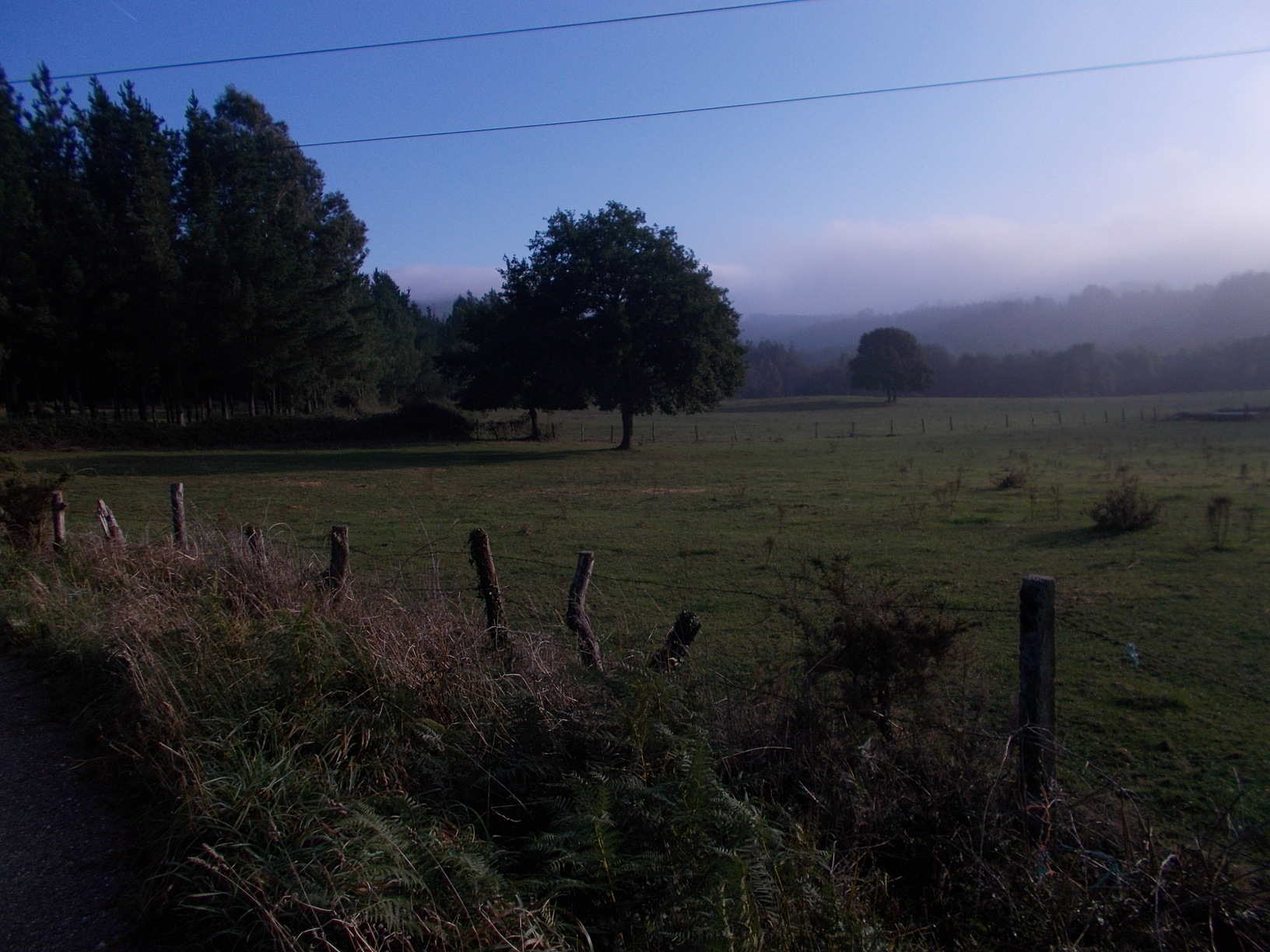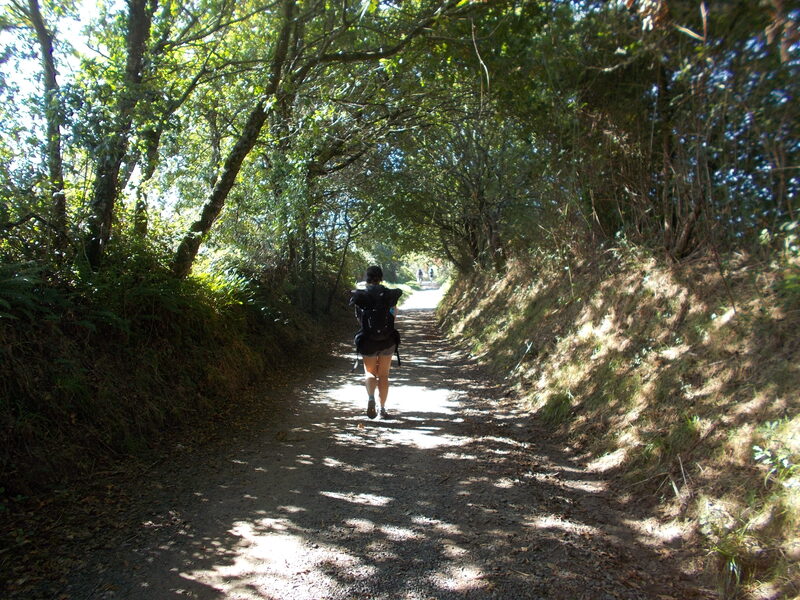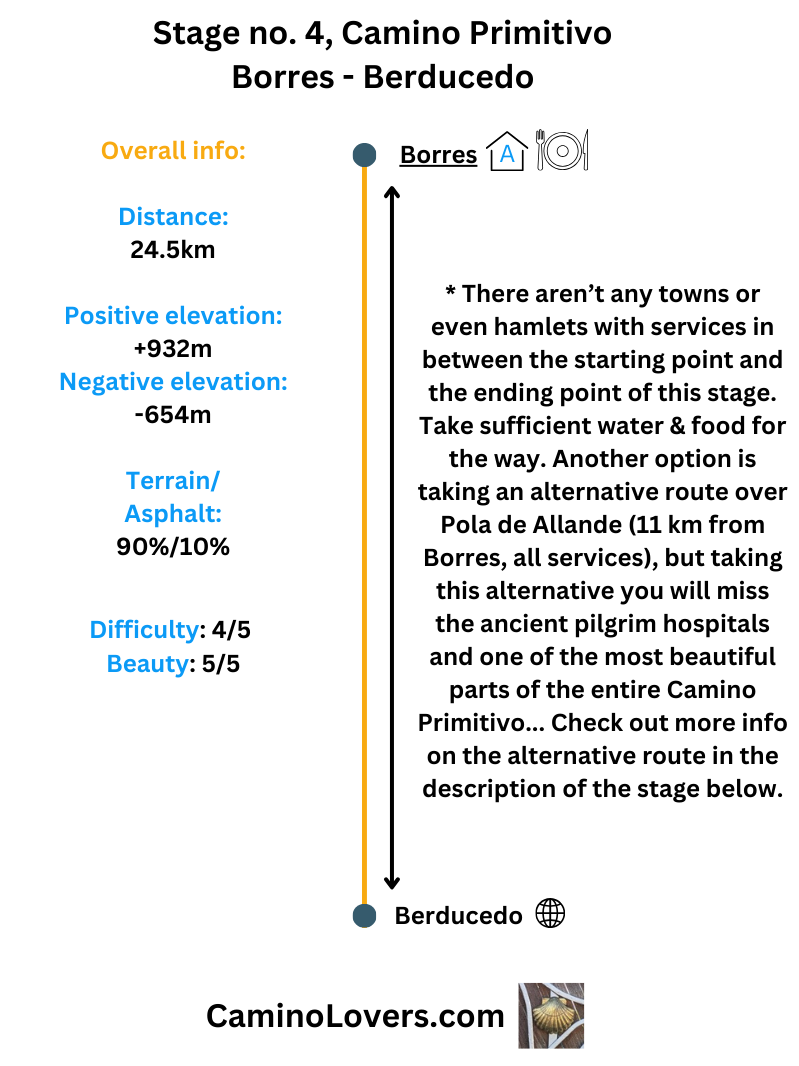
Table of Contents
Basic Details
- Starting point: Borres, a small hamlet of roughly 90 inhabitants with two pilgrim albergues and a bar, the most typical starting point for the most beautiful stage of Camino Primitivo that will lead you over the ancient pilgrim hospitals.
- Ending point: A small village of Berducedo, roughly 160 inhabitants. The village lives completely from the Camino, and in spite how small it is, you will find there 3 pilgrim hostels, shop, restaurant, bar, simply everything a pilgrim needs.
- Availability of alternative routes: Yes. The alternative route avoids the mountain ridge (with the ruins of ancient pilgrim hospitals), and leads you through the valley instead, to a nice town called Pola de Allande, which has three pilgrim albergues, and offers all services for pilgrims. Pilgrims take this alternative mostly in the following scenarios:
- Bad weather or risk of thunderstorms. In this case pilgrims typically just pass Pola, having a snack in a bar and continue to Berducedo.
- Not feeling physically fit for such a long stage, deciding to split it into two parts, sleeping in Pola for the night and continuing to Berducedo on another day.
- Preferring a route which offers more services, and refreshment points along the way. You won’t find any refreshment points on the official Camino. On this route, however, you will find some bar or restaurant on kilometer 6, 11, and with a short detour (well signposted, in a bar Casa Vinas) also on kilometer 15. And then of course in Berducedo, the ending point of today’s walk…
- Distance: Official Camino route: 24.5 km (download GPS here). The alternative route over Pola: 28.5 km (download GPS here).
- Link to online map: Official camino route: here. Alternative Camino route: here.
- Elevation difference: Official camino route: + 932m, – 654m. Alternative route over Pola: + 1203, – 959.
- Difficulty score: Official Camino route: 5/5. Alternative route over Pola: 5/5.
- Beauty score: Official Camino route: 5/5. Alternative route over Pola 4/5.
- Terrain/asphalt: Official Camino route: 90%/10%. Alternative Camino route: 75%/25%. This stage is very unusual for Camino de Santiago in general, with a minimum of asphalt walking. On all major Caminos in Spain (Frances, Norte, Portuguese, Primitivo, Via de la Plata) you won’t find more than 10 stages in total, on all these Caminos, with such a little percentage of asphalt/paved road walking, as you will experience on this beautiful stage. Enjoy it while it lasts, because it never does for too long on the Camino :).
- Next stage: Camino Primitivo, Stage no. 5, Berducedo – Grandas de Salime.
- Previous stage: Camino Primitivo, Stage no. 3, Bodenaya – Borres.
Elevation profiles for the routes
 – Elevation profile of the official camino route, over the ancient pilgrim hospitals. As you can see, it isn’t as bad as it looks on paper. Sure, there are a few short stretches with a gradient of a climb of 15% or more, but they do not count for more than 10% of total distance you will cover. Still, it is considered a hard stage, for you are now truly in the mountains, with no refreshment points, and if you are unlucky on strong winds, or fog, or anything similar, you have no other option than going on until Berducedo.
– Elevation profile of the official camino route, over the ancient pilgrim hospitals. As you can see, it isn’t as bad as it looks on paper. Sure, there are a few short stretches with a gradient of a climb of 15% or more, but they do not count for more than 10% of total distance you will cover. Still, it is considered a hard stage, for you are now truly in the mountains, with no refreshment points, and if you are unlucky on strong winds, or fog, or anything similar, you have no other option than going on until Berducedo.
 – The alternative route over Pola de Allande. Starts easy, with a rather flat section and then a descent to Pola. However, from Pola to the highest point the climb it is even more difficult than the official route, since in the last 3 kilometers the climb is really steep. In my opinion, the alternative route isn’t easier than the official camino. It just avoids the mountain ridge, and offers some refreshment points along the way. But if you walk it on a single day (not staying in Pola de Allande for one night), in terms of numbers (distance, elevation difference, steepness of the climbs) is is even harder than the official camino route over ancient pilgrim hospitals.
– The alternative route over Pola de Allande. Starts easy, with a rather flat section and then a descent to Pola. However, from Pola to the highest point the climb it is even more difficult than the official route, since in the last 3 kilometers the climb is really steep. In my opinion, the alternative route isn’t easier than the official camino. It just avoids the mountain ridge, and offers some refreshment points along the way. But if you walk it on a single day (not staying in Pola de Allande for one night), in terms of numbers (distance, elevation difference, steepness of the climbs) is is even harder than the official camino route over ancient pilgrim hospitals.
Advanced info about the stage
- Trail marking: Really good on the route over ancient hospitals. I walked it in a thick fog for a big part, without using any navigation, and have never had problems finding the way. Plenty of yellow arrows, and even arrows made from stones on the ground, made by pilgrims for other pilgrims. I have not walked the alternative route over Pola de Allande so far (hope to do it this summer), and hence cannot comment on how well this route is signposted.
- Natural places worth seeing: The entire stage is a natural place worth seeing :). This section of Camino Primitivo is humid, and gets a lot of rainfall over the year. Which means it is pretty green during the entire pilgrim season (from early April to Mid November) on Camino Primitivo. Some flowers bloom in each season, you can see horses, cows, and even deer if you’re a bit lucky. Plenty of interesting birds too. Of course, it doesn’t have the beauty of the Himalaya or the Picos de Europa. But it is really nice nevertheless and I sincerely hope you will be more lucky with weather than I was when walking this stage :).
- Historical, architectural, and culinary places worth seeing:
- The chapel of San Pascual Baylon, right on the Camino, location on Google maps here. A nice chapel with a porch that can serve as a place for an emergency bivouac, since it protects a pilgrim well from the rain. Basically from the chapel the climb up to the ridge with ancient pilgrim hospitals starts.
- Ruins of the ancient pilgrim hospital of Paradiella, right on the Camino, exact location here. Some pilgrims are a bit disheartened reaching the place, because what you see there are really just ruins of the ancient pilgrim hospital from 15th century. But with a bit of imagination one can envision what it was back then in the day, to do a pilgrimage, and how lucky we are today, and why those hospitals are only ruins nowadays (since we do not need them any longer :)).
- Ruins of the ancient hospital de Fonfaraon, right on the Camino, location on G. Maps here. The ruins of this pilgrim hospital dating back to 13th century was converted to a small shelter (probably meant for the pastors), very basic, but it can be used as an emergency shelter for a night, should you, for any reason, find yourself here when the sun is already setting down. Some people think that this is the best preserved of the ancient hospitals, but of course it isn’t true, since the new “building” has nothing to do with the original building of the pilgrim hospital.
- The chapel of Santiago de Montefurado, right on the Camino, exact location here. A beautiful and atypical chapel in a small mountain hamlet of Montefurado, which is almost deserted now (I could not find any official numbers, but based on what I found, there do not live more than 10 people at the hamlet now). Very interesting architecture of both the chapel and the hamlet.
- Camping/bivouac options on this stage: Very easy, you can basically camp anywhere on the ridge, even close to one of the ancient pilgrim hospitals, and nobody will bother you there at night. Just make sure not to cross any fences. If I should pick one place in particular, I’d pick the ruins of the hospital of Fonfaraon, simply because there is a covered shelter, which can protect you for the night in case of strong winds or rain.
- Dog friendly score: 4/5. I do not give full score for two reasons. First one is a lack of water on the ridge, especially on dry days. During the rainy period you will always find some puddles of water right on the trail where the dog can drink, but these dry pretty quickly on dry days. Second one is a fact that no albergue in Berducedo accepts dogs. However, considering how easy it is to camp on this stage, it isn’t such a huge minus. And you probably expected to camp with a dog at least on some nights, so this is one of them :). Other than these two things, the stage is excellent for dogs and they will love it.
- Special remarks: Most of the small hamlets and villages in this part of Asturias live solely from the Camino, the pilgrims who pass through. It isn’t an easy life, especially considering there’s nothing going on in winter, but you still have to maintain the place, pay the staff (if you have any), etc. Try to have something in the bars and places along the way (if you can afford it) and be kind to the locals you meet (being kind costs nothing :)). After all, if the infrastructure for pilgrims wasn’t here, walking this way would be almost impossible. We as pilgrims should be grateful to the locals in the area, and appreciate what they do for us.
Pictures from the stage
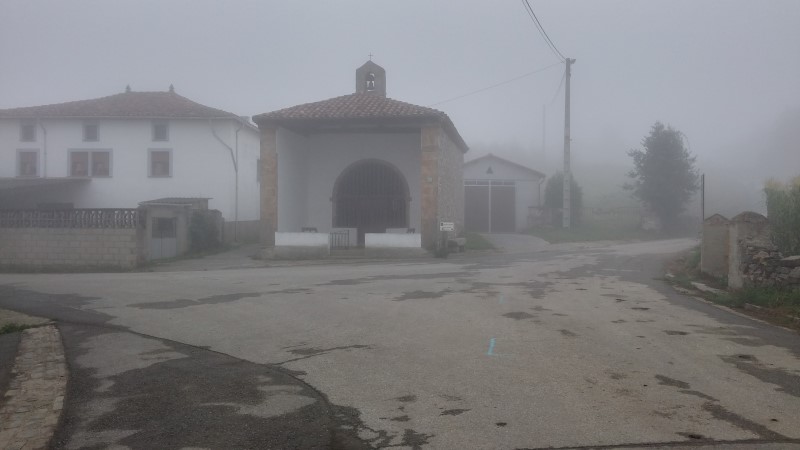 – Chapel of San Pascual, just a few kilometers outside Borres. As you can see on the very first picture, I wasn’t particularly lucky on good weather when walking this stage :).
– Chapel of San Pascual, just a few kilometers outside Borres. As you can see on the very first picture, I wasn’t particularly lucky on good weather when walking this stage :).
 – Life & death are never far away from each other in the mountains…
– Life & death are never far away from each other in the mountains…
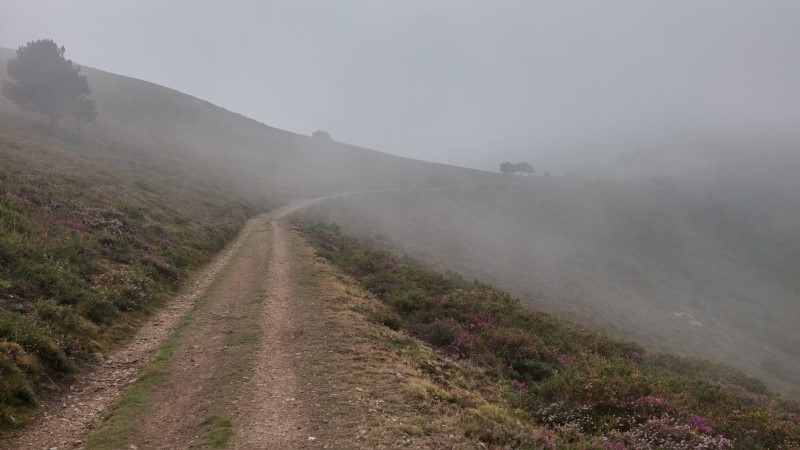 – This is how the dreaded climb up to the ridge with ancient pilgrim hospitals looks like. As you can see, it is a wide path, not technical, perfectly doable on a mountain bike. If you do Camino Primitivo on bicycle, you can take the route over the ancient pilgrim hospitals, with no issues.
– This is how the dreaded climb up to the ridge with ancient pilgrim hospitals looks like. As you can see, it is a wide path, not technical, perfectly doable on a mountain bike. If you do Camino Primitivo on bicycle, you can take the route over the ancient pilgrim hospitals, with no issues.
 – Wild horses on a foggy mountain, near the remains of one of the ancient pilgrim hospitals. Or was it just my imagination that they were wild?
– Wild horses on a foggy mountain, near the remains of one of the ancient pilgrim hospitals. Or was it just my imagination that they were wild?
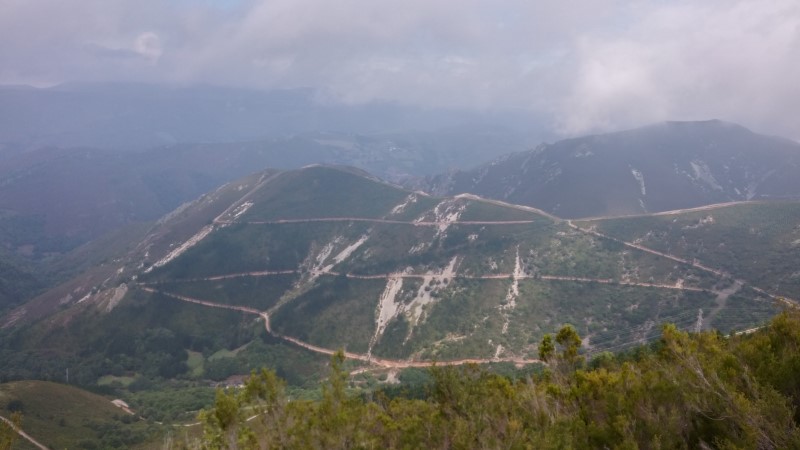 – View from the ridge. I had mixed feelings, seeing so many lodging routes on the face of the mountain in front… But it is what it is. While Spain does great job in nature conservation in national parks around the country, in mountains and forests that aren’t protected by law it is a different story, one in which greed for profit plays the prime…
– View from the ridge. I had mixed feelings, seeing so many lodging routes on the face of the mountain in front… But it is what it is. While Spain does great job in nature conservation in national parks around the country, in mountains and forests that aren’t protected by law it is a different story, one in which greed for profit plays the prime…
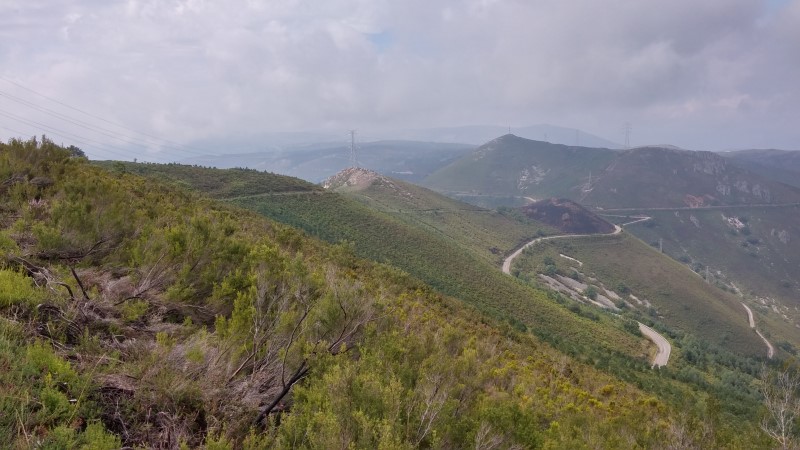 – Another look form the ridge, a more optimistic one. You can see the route you will follow in front of you.
– Another look form the ridge, a more optimistic one. You can see the route you will follow in front of you.
 – Nice nature on the descent do Berducedo, the final point of today’s stage.
– Nice nature on the descent do Berducedo, the final point of today’s stage.
Few tips at the end
- There are no water fountains on the ridge. If you decide to follow the official Camino, try to do some math, thinking about how long you will walk it (approximately), and how much water you will need on such a day. Of course, general recommendations do not exist here, since it is different walking this stage with blazing sun and 30 degrees Celsius and on a rainy day with 5 degrees. Only you know yourself, and how much water you need while walking with a big backpack. Think about it properly, and do not take a certain amount just because another pilgrim takes such, or because you read online that someone took 1 liter, or 3 liters or 5 liters or whatever.
- I also want to stress that this isn’t wilderness like in Alaska, or Indonesia, or the Andes. These are wide dirt routes where even an ambulance can go, and you will meet other pilgrims, or even locals on the trail. What I try to say here is that while it makes sense to take some precautions and do not take this stage lightly, you do not have to be worried of something bad happening to you up there, even if you run out of water. You’ll be fine, and should enjoy this beautiful stage without unnecessary stress. The only real risk are thunderstorms. Consult your host in the albergue in Borres for local weather forecast. If they forecast thunderstorms, I suggest you to opt for the alternative route over Pola de Allande.
- There are over 80 beds in the three albergues in Berducedo, which is pretty much enough even during the highest season on Camino Primitivo. Hence you do not have to worry about making reservations or anything. Just walk in, check the places, and pick one that you like…
Next/Previous Stage
- Next stage: Camino Primitivo, Stage no. 5, Berducedo – Grandas de Salime.
- Previous stage: Camino Primitivo, Stage no. 3, Bodenaya – Borres.
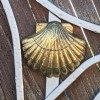



![Ultralight Packing List for Camino de Santiago [2025 Edition]](https://caminolovers.com/wp-content/uploads/2022/03/altra-shoes-640-x-480.jpg)

